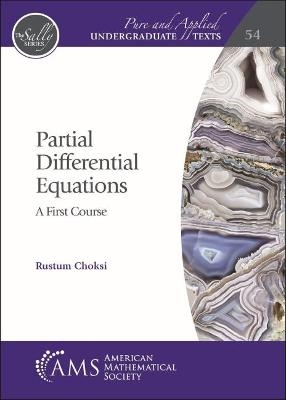
Partial Differential Equations
A First Course
Seiten
2022
American Mathematical Society (Verlag)
978-1-4704-6491-2 (ISBN)
American Mathematical Society (Verlag)
978-1-4704-6491-2 (ISBN)
Written for undergraduate students from different cohorts with one sole purpose: to facilitate a proficiency in many core concepts in PDEs while enhancing the intuition and appreciation of the subject. For mathematics students this will in turn provide a solid foundation for graduate study.
While partial differential equations (PDEs) are fundamental in mathematics and throughout the sciences, most undergraduate students are only exposed to PDEs through the method of separation of variations. This text is written for undergraduate students from different cohorts with one sole purpose: to facilitate a proficiency in many core concepts in PDEs while enhancing the intuition and appreciation of the subject. For mathematics students this will in turn provide a solid foundation for graduate study. A recurring theme is the role of concentration as captured by Dirac's delta function. This both guides the student into the structure of the solution to the diffusion equation and PDEs involving the Laplacian and invites them to develop a cognizance for the theory of distributions. Both distributions and the Fourier transform are given full treatment.
The book is rich with physical motivations and interpretations, and it takes special care to clearly explain all the technical mathematical arguments, often with pre-motivations and post-reflections. Through these arguments the reader will develop a deeper proficiency and understanding of advanced calculus. While the text is comprehensive, the material is divided into short sections, allowing particular issues/topics to be addressed in a concise fashion. Sections which are more fundamental to the text are highlighted, allowing the instructor several alternative learning paths. The author's unique pedagogical style also makes the text ideal for self-learning.
While partial differential equations (PDEs) are fundamental in mathematics and throughout the sciences, most undergraduate students are only exposed to PDEs through the method of separation of variations. This text is written for undergraduate students from different cohorts with one sole purpose: to facilitate a proficiency in many core concepts in PDEs while enhancing the intuition and appreciation of the subject. For mathematics students this will in turn provide a solid foundation for graduate study. A recurring theme is the role of concentration as captured by Dirac's delta function. This both guides the student into the structure of the solution to the diffusion equation and PDEs involving the Laplacian and invites them to develop a cognizance for the theory of distributions. Both distributions and the Fourier transform are given full treatment.
The book is rich with physical motivations and interpretations, and it takes special care to clearly explain all the technical mathematical arguments, often with pre-motivations and post-reflections. Through these arguments the reader will develop a deeper proficiency and understanding of advanced calculus. While the text is comprehensive, the material is divided into short sections, allowing particular issues/topics to be addressed in a concise fashion. Sections which are more fundamental to the text are highlighted, allowing the instructor several alternative learning paths. The author's unique pedagogical style also makes the text ideal for self-learning.
Rustum Choksi, McGill University, Montreal, QC, Canada.
Basic definitions
First-order PDEs and the method of characteristics
The wave equation in one space dimension
The wave equation in three and two space dimensions
The delta ""function"" and distributions in one space dimension
The Fourier transform
The diffusion equation
The Laplacian, Laplace's equation, and harmonic functions
Distributions in higher dimensions and partial differentiation in the sense of distributions
The fundamental solution for Green's functions for the Laplacian
Fourier series
The separation of variables algorithm for boundary value problems
Uniting the big three second-order linear equations and what's next
Objects and tools of advanced calculus
Bibliography
Index
| Erscheinungsdatum | 07.02.2022 |
|---|---|
| Reihe/Serie | Pure and Applied Undergraduate Texts |
| Verlagsort | Providence |
| Sprache | englisch |
| Maße | 178 x 254 mm |
| Gewicht | 1122 g |
| Themenwelt | Mathematik / Informatik ► Mathematik ► Analysis |
| ISBN-10 | 1-4704-6491-8 / 1470464918 |
| ISBN-13 | 978-1-4704-6491-2 / 9781470464912 |
| Zustand | Neuware |
| Haben Sie eine Frage zum Produkt? |
Mehr entdecken
aus dem Bereich
aus dem Bereich
Buch | Softcover (2024)
De Gruyter Oldenbourg (Verlag)
CHF 83,90


